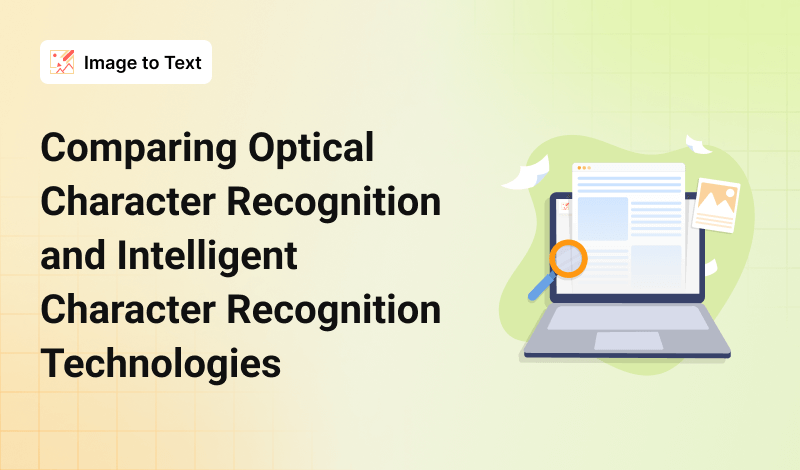Comparing Optical Character Recognition and Intelligent Character Recognition Technologies

Since they can quickly and accurately extract text from a variety of sources, optical character recognition (OCR) is a new technology that is gaining popularity. Intelligent character recognition (ICR) technologies have grown in popularity. ICR technology can only read handwriting, whereas OCR technology can read both printed and handwritten text. This article will examine the parallels and discrepancies between OCR and ICR technologies in order to inform readers about which technology is most appropriate for their individual requirements.
Optical Character Recognition Technology
A type of technology called optical character recognition (OCR) enables the transformation of printed or scanned text into digital text that can be edited, searched, and stored electronically. OCR technology converts text into machine-readable form by identifying characters using image processing algorithms.
The OCR software analyses the text by spotting patterns, shapes, and features before comparing the characters to its internal character database. The database is made up of a variety of fonts, styles, and languages. OCR technology is widely used in a number of sectors, including banking, government, education, and healthcare.
How OCR works
OCR technology works by analyzing the image of a scanned document and recognizing each character using pattern recognition algorithms. The OCR software examines the image to locate and isolate each character, and then identifies the shape, size, and orientation of each character. Once the OCR software has identified the characters, it matches them to its internal database of characters and converts them into machine-readable text. OCR technology can also recognize handwriting, although this is a more complex process and requires specialized software.
Advantages of OCR
OCR technology can automate the data entry process to help with time savings and increase accuracy. Large amounts of text can be accurately and quickly converted by the software into machine-readable format, eliminating the need for manual data entry. By digitizing physical documents and making them simpler to store and manage, OCR technology can also assist businesses in reducing their use of paper. As digital documents require less storage space than physical documents do, this can help lower storage costs. OCR technology can also increase accessibility by enabling people with visual impairments to access printed materials.
Intelligent Character Recognition Technology
Intelligent Character Recognition (ICR) technology is a type of OCR technology that can recognize both printed and handwritten text. ICR technology uses advanced machine learning algorithms to improve recognition accuracy and reduce errors. Unlike OCR, which only recognizes printed text, ICR technology can recognize and interpret the nuances of handwriting.
How ICR works
ICR technology works by analyzing the handwriting in a document and converting it into machine-readable text. The software uses a combination of pattern recognition, artificial intelligence, and machine learning algorithms to identify and interpret the unique features of each character. ICR software can also learn and adapt to new handwriting styles over time, improving recognition accuracy.
Advantages of ICR
ICR technology can recognize both printed and handwritten text, making it useful in a wider range of applications than OCR technology alone. For example, ICR technology can be used in the healthcare industry to digitize handwritten medical notes or in the finance industry to process handwritten checks. ICR technology can also help improve recognition accuracy over time, reducing the likelihood of errors in the final output. This can save time and increase efficiency, particularly in industries where accuracy is critical, such as finance and legal services.
Comparison between OCR and ICR Technologies
Accuracy of OCR and ICR
ICR technology generally has higher accuracy than OCR technology, particularly when it comes to handwriting recognition. However, OCR technology can still be highly accurate for printed text recognition.
Speed of OCR and ICR
OCR technology is generally faster than ICR technology due to its simpler recognition algorithms. ICR technology may take longer to analyze handwriting and improve recognition accuracy over time.
Costs of OCR and ICR
OCR technology is generally less expensive than ICR technology due to its simpler recognition algorithms. ICR technology may require more advanced machine learning algorithms and hardware to achieve high accuracy rates, making it more expensive.
Applications for OCR and ICR
OCR technology is useful for digitizing printed documents, making them searchable and editable in electronic form. OCR technology can be used in a variety of applications such as document management systems, invoice processing, and data entry. ICR technology, on the other hand, is useful for recognizing handwriting in forms and applications. ICR technology can be used in applications such as handwriting recognition in tablets and other electronic devices.
Use cases for OCR and ICR
OCR technology can be used in a variety of industries, including healthcare, legal services, and finance. In healthcare, OCR technology can be used to digitize patient records, while in legal services, it can be used to scan and search legal documents.
In finance, OCR technology can be used for invoice processing and data entry. ICR technology is particularly useful in industries that rely heavily on handwritten forms and documents, such as education, finance, and government. Use cases for ICR technology include handwriting recognition in tablets and other electronic devices, form processing, and handwritten data entry.
Conclusion
OCR technology can recognize printed text, while ICR technology can recognize both printed and handwritten text. ICR technology generally has higher accuracy than OCR technology, but OCR technology is generally faster and less expensive. Businesses should evaluate their specific needs and requirements to determine which technology is best suited for their use case.
If you want to quickly see how OCR works, check out the imagetotext.cc. It will accurately convert your images, screenshots and scanned documents into formats that you can edit right away.



